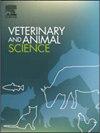Data-independent acquisition-based proteome profiling of red blood cells from dairy buffaloes under different types of heat stress
IF 1.9
Q2 AGRICULTURE, DAIRY & ANIMAL SCIENCE
引用次数: 0
Abstract
Heat stress (HS) induces hypoxia and oxidative stress, reducing animal health and livestock production. Red blood cells (RBCs) are responsible for oxygen delivery, and are susceptible to HS. In this study, 12 healthy buffaloes with a similar body condition, lactation, and parity were raised under thermal-neutral (TN) conditions. After the collection of blood samples, buffaloes were randomly and equally divided into two groups. Six buffaloes underwent acute HS conditions for eight days (AHS group). Subsequently, these six AHS buffaloes were subjected to chronic HS conditions (AHS-CHS group). The other six TN buffaloes were raised under chronic HS conditions (CHS group). RBCs were isolated for data-independent acquisition-based proteomics to identify differentially expressed proteins involved in the HS response. Results showed that blood clotting factors, complements, immunoglobulins, and vasoconstriction proteins in RBCs were consistently decreased under the three types of HS conditions (AHS, AHS-CHS, and CHS). Moreover, the immunity of buffaloes experiencing AHS (AHS and AHS-CHS) was severely decreased when compared to those subjected to CHS. Due to high heat sensitivity of RBCs, AHS conditions should be avoided for dairy buffaloes in summer.
不同类型热应激条件下奶牛红细胞的蛋白质组学分析
热应激(HS)引起缺氧和氧化应激,降低动物健康和牲畜生产。红细胞(rbc)负责氧气输送,易患HS。本研究选用12头体况、哺乳期和胎次相近的健康水牛,在热中性(TN)条件下饲养。采集完血液样本后,将水牛随机平均分为两组。6头水牛经历了8天的急性HS (AHS组)。随后,这6头AHS水牛被置于慢性HS状态(AHS- chs组)。其余6头TN水牛在慢性HS条件下饲养(CHS组)。分离红细胞进行数据独立获取的蛋白质组学研究,以鉴定参与HS反应的差异表达蛋白。结果显示,在AHS、AHS-CHS和CHS三种HS情况下,红细胞中的凝血因子、补体、免疫球蛋白和血管收缩蛋白均呈下降趋势。此外,经历AHS (AHS和AHS-CHS)的水牛与经历CHS的水牛相比,免疫力严重下降。由于红细胞热敏性高,奶牛在夏季应避免发生AHS。
本文章由计算机程序翻译,如有差异,请以英文原文为准。
求助全文
约1分钟内获得全文
求助全文
来源期刊

Veterinary and Animal Science
Veterinary-Veterinary (all)
CiteScore
3.50
自引率
0.00%
发文量
43
审稿时长
47 days
 求助内容:
求助内容: 应助结果提醒方式:
应助结果提醒方式:


